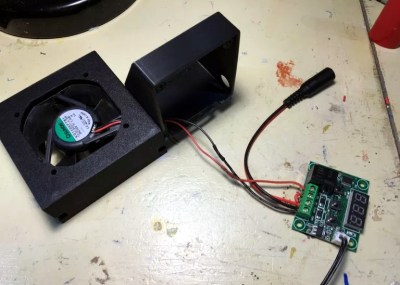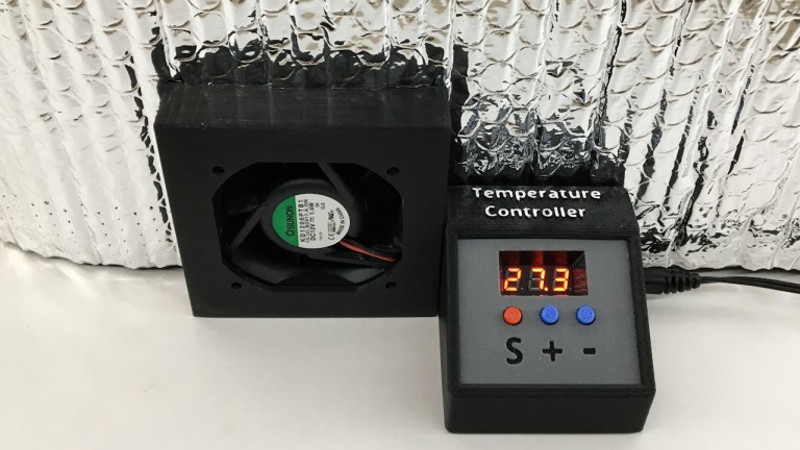There are many annoying issues associated with desktop 3D printers, but perhaps none are trickier than keeping the machine at the proper temperature. Too cold, and printed parts can warp or fail to adhere to the bed. Too hot, and the filament can get soft and jam, or the motors will start clanking and missing steps. High-end industrial 3D printers have temperature-controlled enclosures for precisely this reason, but the best you can hope for with a printer that’s little more than some aluminum extrusion and an Arduino is a heated bed that helps but is no substitute for the real thing.
 Like many 3D printer owners chasing perfect prints, [Steve Thone] ended up putting his machine into a DIY enclosure to help keep it warm. Unfortunately, there gets to be a point when things get a little too hot inside the insulating cube. To address this issue, he put together a simple but very elegant temperature controlled fan to vent the enclosure when the internal conditions go above the optimal temperature.
Like many 3D printer owners chasing perfect prints, [Steve Thone] ended up putting his machine into a DIY enclosure to help keep it warm. Unfortunately, there gets to be a point when things get a little too hot inside the insulating cube. To address this issue, he put together a simple but very elegant temperature controlled fan to vent the enclosure when the internal conditions go above the optimal temperature.
[Steve] picked up the digital temperature controller on Amazon for about $4 USD, and found a 60 mm fan in the parts bin. He then came up with a clever two-part printed enclosure that slides together to make the fan and controller one unit which he can place in a hole he cut in the enclosure.
A lot of attention was paid to the front panel of the device, including mid-print filament swaps to create highlighted text and separate buttons printed in different colors. The end result is a very professional looking interface that involved relatively little manual labor; often a problem when trying to come up with nice looking panels.
Whether it’s to keep from breathing ABS fumes, or to quiet the thing down enough so you can get some sleep, it looks like an enclosure of some type is becoming the latest must-have 3D printer accessory.















Hey, I’m a fan of this idea…
I think it blows
It sucks
Nah, it’s cool.
You are all going around and around.
Interesting idea. I would probably go the other way though, put an incandescent light bulb in there with the printer. Same idea though. I don’t do a lot of printing in the summer and it is not actively heated in the shop in the winter so it does get cold in there. Hmmmm. More important.. I wonder if I should not see if there is a place to put a light bulb in the laser compartment of my laser cutter. The bench is right up against an unheated wall with a hole in it for the printers vent. It would piss me off if the water in the tube managed to freeze and crack the tube on one of our occasional -20 degree f nights in the winter…. It has not froze back there yet, but the laser and it’s hole in the wall are new additions.
Does your printer not have a heated bed? I think you’d find if you enclosed the machine, the cumulative heat output of the stepper motors, hotend, and bed itself would more than enough to get the enclosure up to a nice temperature (let’s say 27C/80F) without any additional heat source. Though it would certainly get up to operating temperature faster with an incandescent bulb in there.
Of course, I suppose it depends on how cold it gets where you are. Here in Northeast US, in winter I have to start considering the room temperature when using my non-heated bed printer.
Yes, I have a heated bed, but I generally print with PLA on tape (on glass but that is just so I can pull the work off with out disturbing the bed level too much. Sleazy I know, but I hate leveling the bed.. Yea, I am lazy). I am trying to recall what the temp in the box did level out at. I was using the reading from the bed thermistor to track the temperature in the enclosure. The enclosure was more to keep drafts off of it when printing, and to keep the printer is a semi dirt and dust free area. Being lazy I am not big on house keeping either.
After a few of the (justifiable) rants on AvE’s channel about cheap chinesium circuits being used on mains currents, would you really trust those controllers for the 110V/10A they claim?
What mains currents? This thing runs on 12V.
That wasn’t the question.
If you look at the parts spec on Amazon, they claim operation on 110/220 (though it’s not very clear which one or both) and the relay operable to 10A at 110/220 (again, not clear). I’d be pretty nervous running an unattended high current device on one of those.
The fan has less than 2W at 12V. Far from a mains circuit.
Although I would not use parts in a mains circuit, which are only rated for 110V. So this parts are perfect for a 12V circuit, if DC rated.
I have no problem using one of the cheep imported temperature controllers to switch on and off a 60W incandescent bulb. I am more concerned about the brain of the controller catching on fire than the relay. And FWIW, DC is a lot harder on relays than AC is, though I doubt a little fan or one 60W bulb is going to weld the contacts together. And that is the typical failure mode. In my bread proofing/herb drying box it tops out at a bit over 100F if the light never goes out in the summer and the other night, I wanted to use it to defrost some frozen strawberries and it could not even hit 100F.
You raise a good point. If you build something with a heater, the thing should be built to withstand having the heater on full time without caching on fire, and the control for the heater should be capable of supplying the required current safely. I try and match the heat source with the need. It makes it both safer and easier to control. I joke about people using army tanks to push baby carriages. That is a recipe for disaster.
Infrared would be the ideal heater imo. Easily controlled by tstat. If too intense one could buy a inexpensive 750w-1500w ceramic heater and use with or without a fan. Same tstat can be used to evacuate excess heat as well. Probably a push pull fan design that isn’t blowing across the part.